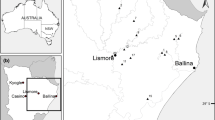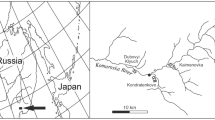Abstract
Stable isotope signatures (δ13C and δ15N) were used to compare trophic linkages between epilithic periphyton and three families of macroinvertebrates (Baetidae, Leptophlebiidae and Gripopterygidae) in riffles of two rivers with developed catchments (including agriculture, urbanization, impoundment and flow regulation) and two with undeveloped catchments (native forest with no major impoundments) in the Murrumbidgee River system, New South Wales, Australia. Periphyton had much higher average δ15N values and lower average C:N ratios in the developed rivers than in the undeveloped rivers, probably because of the combined effects of nutrient enrichment, upstream impoundment and alteration of riparian vegetation. The invertebrates were generally slightly depleted in 13C and 15N relative to expected values if they were assimilating whole periphyton alone, which suggests that they were assimilating periphyton components selectively or also consuming other foods. The match in isotope signatures between periphyton and invertebrates was only slightly weaker in the developed than in the undeveloped rivers, suggesting that development did not greatly disrupt trophic linkages between periphyton and these invertebrates.







Similar content being viewed by others
References
Adams, T. S. & R. W. Sterner, 2000. The effect of dietary nitrogen content on trophic level 15N enrichment. Limnology and Oceanography 45: 601–607.
Allan, J. D., 2004. Landscapes and riverscapes: the influence of land use on stream ecosystems. Annual Review of Ecology and Systematics 35: 257–284.
Anderson, C. & G. Cabana, 2005. δ15N in riverine food webs: effects of N inputs from agricultural watersheds. Canadian Journal of Fisheries and Aquatic Sciences 62: 333–340.
APHA, 1998. Standard Methods for the Examination of Water and Wastewater, 20th ed. American Public Health Association, Washington DC.
Biggs, B. J. F., R. J. Stevenson & R. L. Lowe, 1998. A habitat matrix conceptual model for stream periphyton. Archiv für Hydrobiologie 143: 21–56.
Busse, L. B., J. C. Simpson & S. D. Cooper, 2006. Relationships among nutrients, algae, and land use in urbanized southern California streams. Canadian Journal of Fisheries and Aquatic Sciences 63: 2621–2638.
Cabana, G. & J. B. Rasmussen, 1996. Comparison of aquatic food chains using nitrogen isotopes. Proceedings of the National Academy of Sciences USA 93: 10844–10847.
Carr, G. M., P. A. Chambers & A. Morin, 2005. Periphyton, water quality, and land use at multiple spatial scales in Alberta rivers. Canadian Journal of Fisheries and Aquatic Sciences 62: 1309–1319.
Chessman, B. C., 1986. Dietary studies of aquatic insects from two Victorian rivers. Australian Journal of Marine and Freshwater Research 37: 129–146.
Chessman, B. C., 1995. Rapid assessment of rivers using macroinvertebrates: a procedure based on habitat-specific sampling, family level identification and a biotic index. Australian Journal of Ecology 20: 122–129.
Cummins, K. W. & M. J. Klug, 1979. Feeding ecology of stream invertebrates. Annual Review of Ecology and Systematics 10: 147–172.
Dudley, T. L., S. D. Cooper & N. Hemphill, 1986. Effects of macroalgae on a stream invertebrate community. Journal of the North American Benthological Society 5: 93–106.
Feminella, J. W. & C. P. Hawkins, 1995. Interactions between stream herbivores and periphyton: a quantitative analysis of past experiments. Journal of the North American Benthological Society 14: 465–509.
Finlay, J. C., 2001. Stable-carbon-isotope ratios of river biota: implications for energy flow in lotic food webs. Ecology 82: 1052–1064.
Finlay, J. C., M. E. Power & G. Cabana, 1999. Effects of water velocity on algal carbon isotope ratios: implications for river food web studies. Limnology and Oceanography 44: 1198–1203.
Finlay, J. C., S. Khandwala & M. E. Power, 2002. Spatial scales of carbon flow in a river food web. Ecology 83: 1845–1859.
Harris, G. P., 2001. Biogeochemistry of nitrogen and phosphorus in Australian catchments, rivers and estuaries: effects of land use and flow regulation and comparisons with global patterns. Marine and Freshwater Research 52: 139–149.
Herczeg, A. L., A. K. Smith & J. C. Dighton, 2001. A 120 year record of changes in nitrogen and carbon cycling in Lake Alexandrina, South Australia: C:N, δ15N and δ13C in sediments. Applied Geochemistry 16: 73–84.
Hill, W. R., S. C. Weber & A. J. Stewart, 1992. Food limitation of two lotic grazers: quantity, quality, and size-specificity. Journal of the North American Benthological Society 11: 420–432.
Hillebrand, H., 2008. Grazing regulates the spatial variability of periphyton biomass. Ecology 89: 165–173.
Junger, M. & D. Planas, 1993. Alteration of trophic interactions between periphyton and invertebrates in an acidified stream: a stable carbon isotope study. Hydrobiologia 262: 97–107.
Kendall, C., S. R. Silva & V. J. Kelly, 2001. Carbon and nitrogen isotopic compositions of particulate organic matter in four large river systems across the United States. Hydrological Processes 15: 1301–1346.
Lock, M. A., 1981. River epilithon – a light and organic energy transducer. In Lock, M. A. & D. D. Williams (eds), Perspectives in Running Water Ecology. Plenum, New York: 3–40.
McCutchan, J. H. Jr, W. M. Lewis Jr, C. Kendall & C. C. McGrath, 2003. Variation in trophic shift for stable isotope ratios of carbon, nitrogen, and sulfur. Oikos 102: 378–390.
McNeely, C., S. M. Clinton & J. M. Erbe, 2006. Landscape variation in C sources of scraping primary consumers in streams. Journal of the North American Benthological Society 25: 787–799.
Munn, M. D., R. W. Black & S. J. Gruber, 2002. Response of benthic algae to environmental gradients in an agriculturally dominated landscape. Journal of the North American Benthological Society 21: 221–237.
O’Reilly, C. M., R. E. Hecky, A. S. Cohen & P.-D. Plisnier, 2002. Interpreting stable isotopes in food webs: recognizing the role of time averaging at different trophic levels. Limnology and Oceanography 47: 306–309.
Peterson, C. G., 1987. Gut passage and insect grazer selectivity of lotic diatoms. Freshwater Biology 18: 455–460.
Peterson, B. J. & B. Fry, 1987. Stable isotopes in ecosystem studies. Annual Review of Ecology and Systematics 18: 293–320.
Post, D. M., 2002. Using stable isotopes to estimate trophic position: models, methods, and assumptions. Ecology 83: 703–718.
Rezanka, K. M. & A. E. Hershey, 2003. Examining primary producer-consumer interactions in a Lake Superior tributary using 15N-tracer, grazer-reduction, and nutrient-bioassay experiments. Journal of the North American Benthological Society 22: 371–387.
Schofield, K. A., C. M. Pringle, J. L. Meyer & E. J. Rosi-Marshall, 2008. Functional redundancy of stream macroconsumers despite differences in catchment land use. Freshwater Biology 53: 2587–2599.
Shields, J. & R. Good, 2002. Environmental water in a regulated river system: the Murrumbidgee River planning approach to the determination of environmental needs. Water Science and Technology 45: 241–249.
Steffy, L. Y. & S. S. Kilham, 2004. Elevated δ15N in stream biota in areas with septic tank systems in an urban watershed. Ecological Applications 14: 637–641.
Steinman, A. D., P. J. Mulholland & W. R. Hill, 1992. Functional responses associated with growth form in stream algae. Journal of the North American Benthological Society 11: 229–243.
Tank, J. L., J. L. Meyer, D. M. Sanzone, P. J. Mulholland, J. R. Webster, B. J. Peterson, W. M. Wollheim & N. E. Leonard, 2000. Analysis of nitrogen cycling in a forest stream during autumn using a 15N-tracer addition. Limnology and Oceanography 45: 1013–1029.
Thorp, J. H., M. D. Delong, K. S. Greenwood & A. F. Casper, 1998. Isotopic analysis of three food web theories in constricted and floodplain regions of a large river. Oecologia 117: 551–563.
Toda, H., Y. Uemura, T. Okino, T. Kawanishi & H. Kawashima, 2002. Use of nitrogen stable isotope ratio of periphyton for monitoring nitrogen sources in a river system. Water Science and Technology 46: 431–435.
Udy, J. W. & S. E. Bunn, 2001. Elevated δ15N values in aquatic plants from cleared catchments: why? Marine and Freshwater Research 52: 347–351.
Vander Zanden, M. J. & J. B. Rasmussen, 1999. Primary consumer δ13C and δ15N and the trophic position of aquatic consumers. Ecology 80: 1395–1404.
Wetzel, R. G., 1983. Limnology, 2nd ed. Saunders, Philadelphia.
Acknowledgements
This study was undertaken by the former NSW Department of Land and Water Conservation (DLWC). Several former staff of DLWC in addition to the authors contributed through fieldwork (in particular David Hohnberg and Justin Nancarrow) and preparation of Fig. 1 (Sandy Grant). Staff of Griffith University, especially Stuart Bunn, Joanne Clapcott and Michelle Winning are thanked for performing the stable isotope analysis and providing advice on methods and data interpretation. River flow and temperature data were obtained from the Hydsys data base of the NSW Department of Water and Energy.
Author information
Authors and Affiliations
Corresponding author
Additional information
Handling editor: M. Power
Rights and permissions
About this article
Cite this article
Chessman, B.C., Westhorpe, D.P., Mitrovic, S.M. et al. Trophic linkages between periphyton and grazing macroinvertebrates in rivers with different levels of catchment development. Hydrobiologia 625, 135–150 (2009). https://doi.org/10.1007/s10750-009-9702-3
Received:
Revised:
Accepted:
Published:
Issue Date:
DOI: https://doi.org/10.1007/s10750-009-9702-3




